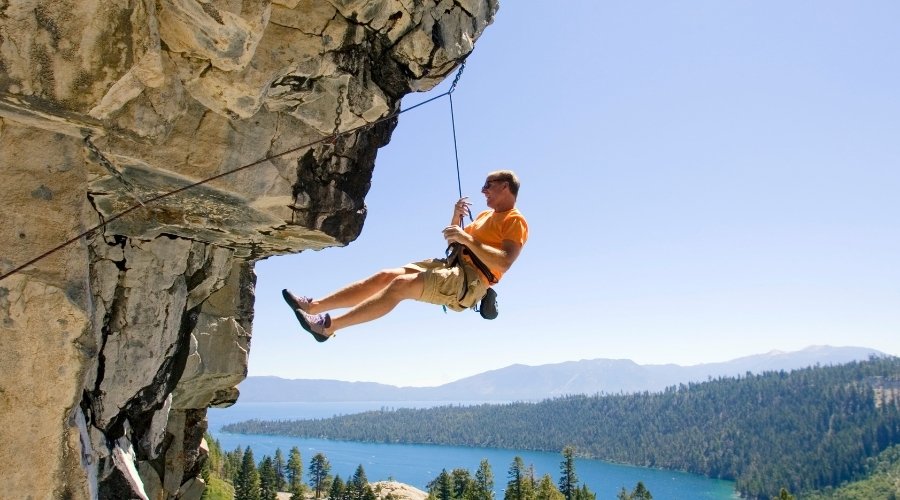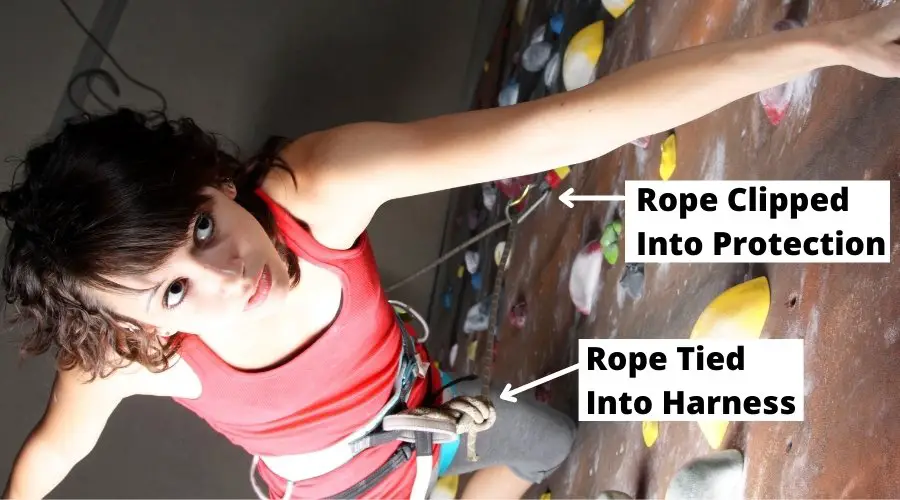Before I went rock climbing outside for the first time, I didn’t have a solid idea of how rope management actually worked. I was only familiar with the auto-belay top rope setups and bouldering walls at my local climbing gym. I never really thought about how climbers initially get their rope up the wall when climbing outside and how they get it back after they finish climbing. Well, after years of climbing experience I am proud to say I know the answer to that now.
Generally, rock climbers get their rope up by taking it with them and attaching it to protection set in the rock during their first ascent. After climbing the route, climbers get their rope back by having one climber belay while the other detaches the rope from the protection set in the rock.
While the above statement generally holds true for all types of climbing that require ropes, each discipline (sport, trad, and top rope) requires climbers to handle the rope a bit differently. For example, getting the rope up and down is a much different process for multi-pitch trad climbing than it is for a single-pitch sport climb. These differences are explored in greater detail below.
If you are interested in seeing what the current prices are for the most popular climbing ropes, you can find them on Amazon by clicking here. Using the Amazon affiliate link above and/or other links in the article helps support this website.
How Rock Climbers Get Their Ropes Up
Climbing is typically a two person operation and has one climber belay at the bottom of the pitch/route while the other climbs up. (Belaying from above is possible but typically only occurs during multi-pitch climbing which is a bit more involved than single pitch). Single pitch climbs can be climbed by the use of a single rope whereas multi pitch climbs are too long for the rope to stretch from top to bottom.

The simplest and easiest way to get a rope up a wall is to take it with you as you climb. Sport and trad climbing do essentially this.
Sport and Trad Climbing
While the climber is making their first ascent of the route, they will have the rope attached to the harness they are wearing. As they scale the wall they will either be attaching the rope to pre-existing protection (sport climbing) or to protection that they are placing (trad climbing) on the wall. Protection will typically be spaced about 2 to 3 meters (6 to 10 feet) apart but this distance will vary depending on the rock characteristics.
This process of attaching the rope to the protection placed on the rock is referred to as “clipping”.
Once the climber has reached the top of the route, they will have clipped into all of the protection on the way up and will have “dragged” the rope with them by using the harness on their waist.

Top Rope
By definition, top roping requires a rope to be set at the top of the route before a climber begins their ascent. Most climbing gyms will have fixed top rope machines (auto-belays) available for climbers to use without having to have a partner on belay. However, these machines do not just magically appear for you at your local crag.
Traditional top roping (not on auto-belay) involves having one end of the rope attached to the climber and the other attached to the belayer. This rope is threaded through an “anchor” at the top of the route. Getting the rope up initially to the top is most commonly done by having one climber sport climb the route and build the top rope anchor.
The video below briefly details different ways of setting up a top rope anchor once the rope has been brought to the top of the route.
The video above is only meant to help demonstrate what top rope anchors are and what they look like. Before building any anchor you will be climbing on, consult a certified instructor to ensure you will be doing it properly and safely.
After this anchor is set, climbers are able to top rope on the route for however long they desire. Once they finish their session, they will need to climb back up the route to retrieve their gear (and rope). This process is known as “cleaning” the anchor/route and is discussed further below.
How Rock Climbers Get Their Ropes Back Down
Climbing rope (and gear in general) is incredibly expensive and is treated like gold by many climbers. (Especially because the typical climber is someone who tends to value experiences and adventure and is not some billionaire who has 7 yachts). So once climbers have had their fill for the session, they will remove their precious rope and other gear from the route and take it with them.
This is done in a few different ways depending on the climbing type that they were doing.
Single Pitch Climbing
Typically getting your rope down from a single pitch climbing session is very similar no matter the climbing type performed. It usually involves one climber sending the route and having the other belay them while they remove the rope/gear starting at the top and going to the bottom.
On average, sport climbing routes will have an anchor point at the top of the route (which can be used for top roping as well). Climbers are able to use this anchor point to descend the route (via belay) and remove their quickdraws on the way down.
The YouTube video below briefly details the process of lowering off a sport anchor in order to get gear and the rope back down after climbers have finished their session.
Once again, the video above is just an example of the process of lowering off an anchor and you should not attempt to do this by yourself until you have been trained by a certified instructor.
After cleaning the anchor (and any other gear from the route), the climber is carefully lowered to the ground with the rope attached and they are able to pull it through the rest of the way. Therefore keeping their rope for future climbing use.
Multi-Pitch Climbing
Multi-pitch climbing works slightly differently than single pitch climbs. Because climbing ropes are not long enough to cover the entire length of a multi-pitch route, climbers are forced to continually bring their rope up the route with them (until they reach the top).
To do this, once the first (lead) climbing partner reaches a good set point, the climber originally belaying them at the bottom of the pitch (the second) will then have to climb up the route while they get belayed by the other from above. The second climber then cleans the route as they climb and takes the bottom of rope up with them while the climber on belay at the top is pulling slack out of it.
Multi-pitch routes typically can be hiked down from on a different side of the mountain/cliff without having to worry about rappelling down the route. If hiking out is not an option, then climbers rappel down and take their rope with them that way.

